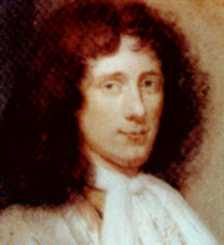Christiaan Huygens
From the Quicksilver Metaweb.
The Quicksilver page for Galileo's Intellectual heir
Stephensonia
Enoch Root views him being wanted to create the vocabulary of the new discipline of Natural Philosophy.
Authored entries
- Boyle's Law, aka Hooke's, Boyle's, and Mariotte's Law (Neal Stephenson)
- Stephenson:Neal:Quicksilver:3:October 12, 1713, 10:33:52 A.M. (Alan Sinder)
- Stephenson:Neal:Quicksilver:6:Cartesian number-line (Neal Stephenson)
- Stephenson:Neal:Quicksilver:78:Isaac Barrow (Neal Stephenson)
- Stephenson:Neal:Quicksilver:707:Huygens's house (Neal Stephenson)
Community entry: Christiaan Huygens
grabbed from Wikipedia
Christiaan Huygens (April 14, 1629 - July 8, 1695) was a Dutch mathematician and physicist; born in The Hague. Huygens is commonly associated with the Scientific Revolution. He was the son of Constantijn Huygens.

Christiaan Huygens
Christiaan is generally given minor credit for his role in the development of modern calculus. He is also notable for his arguments that light consisted of waves; see: wave-particle duality. In 1655, he discovered Saturn's moon Titan. He also examined Saturn's planetary rings, and in 1656 he found out those rings consisted of rocks. In the same year he observed the Orion Nebula. Using his modern telescope he was able to divide the nebula into different stars. The brighter interior of the Orion Nebula is called the Huygens Region. He also discovered several interstellar nebulae and some double stars.
After Blaise Pascal encouraged him to do so, Huygens wrote the first book on probability theory, which was published in 1657.
He also worked on the construction of accurate clocks, suitable for naval navigation. In 1658 he published a book on this topic called Horologium. Huygens was elected a member of the Royal Society in 1663. In the year 1666 Huygens moved to Paris where he held a chair at the French Royal Society. Using the Parisian observatory, which was completed in 1672, he made further astronomical observations.
Huygens was one of the first writers to speculate in detail about life on other planets (although we do not know to which extent ancient writers exercised such speculation, since most of their work has not survived). In his book The celestial worlds discover'd: or, conjectures concerning the inhabitants, plants and productions of the worlds in the planets he imagined a universe brimming with life, much of it very similar to life on 17th century Earth. It was the liberal climate in the Netherlands of that time which not only allowed but encouraged such speculation. In sharp contrast, Italian philosopher Giordano Bruno, who also believed in many inhabited worlds, was burned at the stake for his beliefs in 1600.
In 1675, Christian Huygens patented a pocket watch.
Huygens moved back to The Hague in 1681 after serious illness and died there 14 years later on July 8, 1695.
Cassini-Huygens
The lander for the Saturn moon Titan that is part of the Cassini probe was named after Huygens. The Huygens probe, supplied by the European Space Agency (ESA) and named after the Dutch 17th century astronomer Christiaan Huygens, successfully scrutinized the clouds, atmosphere, and surface of Saturn's moon Titan. It was designed to enter and brake in Titan's atmosphere and parachute a fully instrumented robotic laboratory down to the surface. The Huygens probe system consists of the probe itself, which descended to Titan, and the probe support equipment (PSE), which remained attached to the orbiting spacecraft. The PSE includes the electronics necessary to track the probe, to recover the data gathered during its descent, and to process and deliver the data to the orbiter, from which it was transmitted or "downlinked" back to Earth (although due to technical problems, some of the data had to be recovered directly from Huygens by Earth-based radio telescopes). Cassini-Huygens is an international collaboration between three space agencies. Seventeen nations contributed to building the spacecraft. The Cassini orbiter was built and managed by NASA's Jet Propulsion Laboratory. The Huygens probe was built by the European Space Agency. The Italian Space agency provided Cassini's high-gain communication antenna. More than 200 scientists worldwide are studying the data collected.
The probe remained dormant throughout the 6.7-year interplanetary cruise, except for bi-annual health checks. These checkouts followed preprogrammed descent scenario sequences as closely as possible, and the results were relayed to Earth for examination by system and payload experts.
Prior to the probe's separation from the orbiter, a final health check was performed. The "coast" timer was loaded with the precise time necessary to turn on the probe systems (15 minutes before the encounter with Titan's atmosphere), and then the probe separated from the orbiter and coasted to Titan for 22 days with no systems active except for its wake-up timer.
The main mission phase was the parachute descent through Titan's atmosphere. The batteries and all other resources were sized for a Huygens mission duration of 153 minutes, corresponding to a maximum descent time of 2.5 hours plus at least 3 additional minutes (and possibly a half hour or more) on Titan's surface. The probe's radio link was activated early in the descent phase, and the orbiter "listened" to the probe for the next 3 hours, which included the descent plus 30 minutes after impact. Not long after the end of this three-hour communication window, Cassini's high-gain antenna (HGA) was turned away from Titan and toward Earth.
Related entries
- Pierre de Fermat
- Blaise Pascal
- Baruch de Spinoza
- Robert Hooke
- Louis XIV
- Natural Philosophy
- Royal Society
- Enoch Root
- Optics
- Color and light
- Longitude
- Natural Philosophy
- Time zone
External links
- Christiaan Huygens Wikipedia entry
- Cassini-Huygens Mission to Saturn Overview
- Final approach for NASA's Saturn probe Cassini-Huygens zooms toward June 30 encounter
- More on Cassini